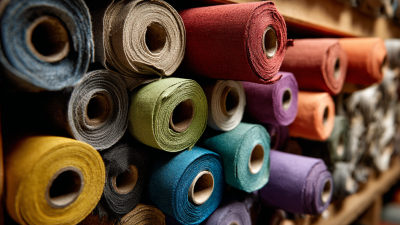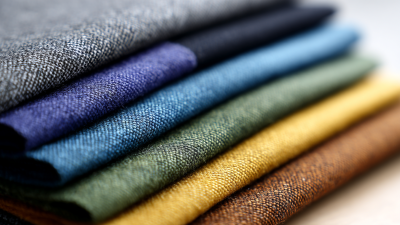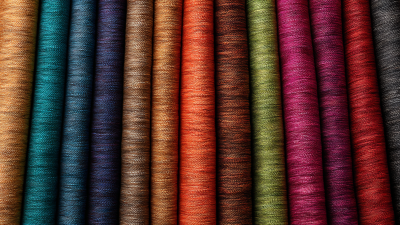The fashion industry faces a significant challenge as it grapples with sustainability and environmental impact, accounting for approximately 10% of global carbon emissions according to the Fashion Industry Charter for Climate Action. As consumers increasingly demand eco-friendly options, brands are turning to innovative materials to reduce their ecological footprint.

One such breakthrough is the use of Recycled Nylon Fabric, which is not only more sustainable but also offers comparable performance to traditional fabrics. According to a report by the Ellen MacArthur Foundation, replacing virgin nylon with recycled alternatives could cut greenhouse gas emissions by up to 80%. This shift not only propels the industry towards a circular economy but also provides an opportunity for brands to align with the values of a conscious consumer base.
As we explore the transformative potential of Recycled Nylon Fabric, it becomes evident that this innovative material is poised to revolutionize the future of sustainable style.
Recycled nylon is quickly gaining traction in the fashion industry as a sustainable alternative to virgin materials. The global market for recycled nylon is projected to reach USD 5.7 billion by 2026, with a compound annual growth rate (CAGR) of 8.2% from 2021 to 2026. The push for sustainability has led brands to explore innovative materials like recycled nylon, which is made from post-consumer waste such as discarded fishing nets and fabric scraps. This not only reduces the environmental footprint but also promotes circular economy practices within the textile sector.
Investment in technological advancements is essential for the growth of recycled nylon. For instance, initiatives like the partnership between Samsara Eco and NILIT are pioneering the establishment of recycling facilities specifically designed for nylon 6,6. Such developments are crucial as they enable the industry to process and regenerate used nylon into high-quality fibers, ensuring a consistent supply of sustainable materials. As consumers become more eco-conscious, the demand for products made from recycled sources will likely continue to surge.
**Tips:** When shopping for sustainable fashion, look for labels indicating the use of recycled materials. Additionally, consider brands that emphasize transparency in their sourcing and production processes, as this often reflects a commitment to environmental responsibility. Embracing sustainable choices not only benefits the planet but can also lead to unique fashion statements.
This bar chart illustrates the percentage of recycled nylon usage in various fashion segments, showcasing how it contributes to sustainable style.
The environmental impact of traditional fabrics, such as cotton and polyester, is significant and concerning. According to the World Resources Institute, producing one kilogram of conventional cotton requires about 10,000 liters of water, contributing to severe water scarcity in many regions. Furthermore, the cultivation of cotton often involves the use of harmful pesticides and fertilizers, leading to soil degradation and water contamination. In contrast, recycled nylon fabric presents a more sustainable alternative, addressing some of these pressing environmental issues.
Recycled nylon, typically sourced from post-consumer waste like discarded fishing nets and fabric scraps, not only reduces the need for virgin materials but also minimizes harmful emissions. A study by the Textile Exchange revealed that using recycled nylon can reduce greenhouse gas emissions by nearly 79% compared to producing nylon from fossil fuels. Additionally, recycling nylon helps divert waste from landfills and oceans, contributing to a circular economy model. As consumers increasingly seek sustainable fashion options, the transition to recycled nylon fabric is becoming a crucial aspect of eco-conscious design, signaling a pivotal shift towards a more sustainable future in the fashion industry.
| Fabric Type | Production Carbon Footprint (kg CO2e per kg) | Water Usage (liters per kg) | Recyclability | Durability (years) |
|---|---|---|---|---|
| Cotton | 2.5 | 10,000 | No | 5 |
| Polyester | 5.5 | 130 | Yes (with proper facilities) | 10 |
| Recycled Nylon | 3.2 | 75 | Yes | 7 |
| Linen | 1.7 | 600 | No | 10 |
As the fashion industry grapples with the environmental impacts of its practices, innovative brands are stepping up to redefine sustainable style through the use of recycled nylon fabric. Leaders in this movement are not just focusing on the aesthetic appeal of their designs, but are also committed to creating a positive impact on the planet. These brands utilize post-consumer waste, such as discarded fishing nets and fabric scraps, transforming them into high-quality nylon products. This approach not only diverts materials from landfills but also reduces the carbon footprint associated with conventional nylon production.
Among the trailblazers pioneering this sustainable trend are companies like Rothy's and Patagonia.
 Rothy's, for instance, has become famous for turning recycled materials into chic, comfortable footwear that resonates with eco-conscious consumers. Similarly, Patagonia has been instrumental in promoting the use of recycled nylon in their activewear, ensuring durability while maintaining a commitment to environmental stewardship. By innovating within their supply chains and focusing on circular fashion principles, these brands are setting a standard for how the industry can evolve to meet the demands of sustainability without compromising style.
Rothy's, for instance, has become famous for turning recycled materials into chic, comfortable footwear that resonates with eco-conscious consumers. Similarly, Patagonia has been instrumental in promoting the use of recycled nylon in their activewear, ensuring durability while maintaining a commitment to environmental stewardship. By innovating within their supply chains and focusing on circular fashion principles, these brands are setting a standard for how the industry can evolve to meet the demands of sustainability without compromising style.
 Recycled nylon is making a significant impact on sustainable fashion, allowing consumers to embrace chic style without compromising on eco-friendliness. According to a 2020 report from the Global Fashion Agenda, the production of recycled nylon can reduce carbon emissions by up to 80% compared to virgin nylon. This transformative material not only minimizes waste but also repurposes plastic that could otherwise pollute our oceans and landfill. By integrating recycled nylon into their collections, brands are setting a new standard for sustainability and opening doors for consumers to make more informed choices.
Recycled nylon is making a significant impact on sustainable fashion, allowing consumers to embrace chic style without compromising on eco-friendliness. According to a 2020 report from the Global Fashion Agenda, the production of recycled nylon can reduce carbon emissions by up to 80% compared to virgin nylon. This transformative material not only minimizes waste but also repurposes plastic that could otherwise pollute our oceans and landfill. By integrating recycled nylon into their collections, brands are setting a new standard for sustainability and opening doors for consumers to make more informed choices.
Styling recycled nylon offers plenty of opportunities to create trendy outfits while showcasing your commitment to the environment. Pairing a sleek recycled nylon jacket with high-waisted jeans creates a modern, casual look, perfect for a day out. Accessories made from similar sustainable materials, such as biodegradable sandals or organic cotton bags, can elevate the ensemble. Furthermore, with the increasing availability of recycled nylon garments—projected to grow by 30% per year by 2025 (as reported by Textile Exchange)—fashion enthusiasts can invest in stylish pieces that not only feel good but also contribute to a healthier planet.
 Caring for recycled nylon garments is essential for prolonging their lifespan and minimizing environmental impact. First, always follow the care instructions provided by the manufacturer. This typically involves washing in cold water and using a gentle cycle to prevent wear and tear. Avoid using harsh detergents that contain bleach or fabric softeners, as these can damage the fibers. Instead, opt for eco-friendly detergents that are gentle on the fabric and the planet.
Caring for recycled nylon garments is essential for prolonging their lifespan and minimizing environmental impact. First, always follow the care instructions provided by the manufacturer. This typically involves washing in cold water and using a gentle cycle to prevent wear and tear. Avoid using harsh detergents that contain bleach or fabric softeners, as these can damage the fibers. Instead, opt for eco-friendly detergents that are gentle on the fabric and the planet.
Additionally, when drying recycled nylon items, air drying is the best method. If you must use a dryer, select a low heat setting to avoid shrinking and weakening the fibers. It’s also wise to store these garments in a cool, dry place and avoid hanging them for prolonged periods, which can cause stretching. By following these simple care tips, you can ensure that your recycled nylon clothing remains stylish and functional for years to come, supporting sustainable fashion practices while reducing waste.






